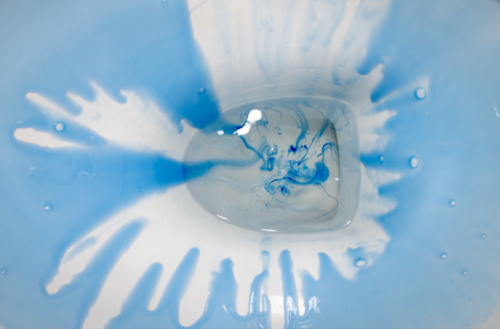Toilet cleaners use dyes to help with identification, which in turn, prevents contamination. The problem is that the blue dye can leave a stubborn stain that can be unsightly and difficult to remove if you don’t address it quickly. Also, toilet cleaners contain harsh chemicals that can harm the skin if left for a long time. Luckily, there are a few tips and techniques that you can follow to remove the blue toilet cleaner from your hands and prevent any potential harm. Let’s learn how to get blue toilet cleaner off hands and other places.
Steps on How to Remove Blue Toilet Cleaner Stains from Hands
The key to preventing blue toilet cleaner stains is to be careful when using the cleaner. Always use the product as directed and avoid spilling it on your hands or surfaces. But if you do end up with blue toilet cleaner on your hands, here’s what to do:
Rinse Your Hands with Running Water
Rinsing thoroughly with cool water will help to remove as much of the cleaner as possible. Avoid using hot water, which can open pores and allow the cleaner to penetrate deeper into your skin. Also, hot water combined with the chemicals in the cleaning product can irritate your skin.
Be sure to rinse off the dye immediately to increase the chances of success. Otherwise, the stain might soak into your skin, making it more difficult to remove and increasing the risk of staining.
Remember to focus on where the dye is likely concentrated. This is usually around the fingertips and under the nails.
Apply Soap
The next step is to apply a small amount of soap to your hands. This will help break down the cleaner and help remove any remaining residue. You can use dish soap or laundry detergent. The latter option acts fast to remove the blue toilet cleaner, but it can be too harsh and irritate sensitive skin.
Scrub Your Hands
Use a piece of cloth or a soft-bristled brush to scrub your hands. Pay attention to your fingertips and under the nails where the cleaner is likely concentrated. Be gentle when scrubbing your hands, as too much pressure can irritate your skin.
Rinse
After scrubbing, rinse your hands thoroughly with cool water to remove soap and any residual cleaner. You can dry your hands with a clean towel or air-dry them.
What Are The Other Toilet Cleaner Stain Removers?
Ideally, the blue toilet cleaner should go away after washing thoroughly with cool water and soap. But this stain can be quite difficult, especially when it sits for a long time. In that case, you may need alternative methods that can help remove these ugly stains from your hands, like:
Washing Your Hands With White Vinegar
White vinegar is a confirmed home remedy often used to remove stains. After rinsing your hands with cool water, apply a small amount of white vinegar. Vinegar works like an exfoliator to remove dead skin cells and the dye as well, thus making the skin to appear fresher and brighter.
Let the vinegar sit for some time, and then scrub your hands with your fingertips or using a soft-bristled brush. Rinse thoroughly with cool water, and the stains will disappear or fade. You can repeat the process to ensure the stain is completely gone. Be sure not to overuse the vinegar as that can leave your skin dry, leading to further irritation.
Applying Baking Soda
Baking soda is another powerful toilet cleaner stain remover. It can break down the dye’s active ingredients, and the best part is it’s only mildly abrasive.
Mix baking soda with water, lemon juice, or vinegar to make a thick paste. Apply the paste on your hands and let it sit for 10-15 minutes. Then scrub your hands together while paying attention to the fingertips and under the nails. Rinse with water and repeat as needed until the stain is gone.
Using Rubbing Alcohol
Rubbing alcohol removes even the most stubborn stains, but be careful when applying it to your skin. Start by applying the alcohol on a cotton ball or pad and gently rub these on your hands.
You’ll notice the dye start to fade away and disappear. Your hand may appear red after cleaning, but this results from rubbing and is nothing to worry about. Your skin and hands should return to normal after some time.
Hydrogen Peroxide
This is a natural bleaching agent, and it’s generally safe for use on the skin. Use it sparingly, though, as hydrogen peroxide can be harsh, especially on sensitive skin. The regular 3% hydrogen peroxide available over the counter is safer.
Apply a small amount of the liquid to a cotton ball or pad, then let the cotton sit on the affected areas for 10-15 minutes. Scrub your hands with a soft-bristle brush, and then rinse with cool water. You may repeat the process to ensure all the blue toilet cleaner stain is gone.
Using a Mildly Abrasive Hand Cleaner
As stated earlier, regular soap may not be able to clear blue stains off your hands. The good news is some mildly abrasive hand cleaners can do the job well. Apply a moderate amount of the hand cleaner, scrub your hands, and rinse with water.
You can also get professional stain removers. Check the label to ensure it is safe on the skin. And carefully follow the instructions.
Are Toilet Cleaners Harmful?
Toilet cleaners cut through grime and grease and disinfect surfaces from dangerous microorganisms. Now imagine what they can do to your delicate skin.
The cleaning products generally contain loads of chemicals, including bleach, hydrochloric acid, ammonia, and sodium hypochlorite, to name a few. While these chemicals do a great job of keeping toilets clean and sparkling, they come at a cost. If they come into contact with the skin, they can cause skin irritation, burns, or blisters. Additionally, toilet cleaners contain fragrances and dyes that can cause allergies and stains.
Blue toilet cleaner stains on your hands mean your skin has come into contact with these harmful chemicals. While the steps outlined above are generally effective in removing blue toilet cleaner from your hands, you can avoid all that trouble by taking some preventive measures. These measures will also prevent or reduce the exposure to harmful chemicals in toilet cleaners.
First, read the label on the cleaning product carefully and then follow the instructions for use. You also want to be extra careful when cleaning with the blue toilet cleaner to avoid stains on your hands. Most importantly, avoid touching your face and other sensitive body parts when handling blue toilet cleaners to prevent transferring the cleaner onto your skin.
Other preventive measures include:
Wearing Gloves and Other Preventive Clothing

It’s important to use the right PPEs when handling toilet cleaners. This will prevent direct contact with your skin and protect it from harmful chemicals, blue stains, irritation, or damage. This is especially important for sensitive skin or people prone to allergies.
Apply a Barrier Cream
In addition to using PPEs, you also need a barrier cream/lotion to protect your skin. These creams are specially formulated to create a protective layer on your skin so the dye cannot be absorbed into your skin. They also help to keep irritants away and prevent irritation from the gloves you’re wearing. Be sure to read the instructions and apply the cream as instructed.
Use a Tool to Apply the Cleaner
Another way to reduce exposure is to use a toilet brush or sponge to apply the cleaner and wash the toilet. This reduces direct contact with the cleaner, thus minimizing staining.
How to Get Rid of Blue Stain on Toilet Seat
As mentioned earlier, many toilet cleaners contain dyes for easy identification. The problem is when the dye gets outside the toilet bowl, like on the toilet seat, lid, or hard-to-reach spots, where it leaves stains.
The first step is to rinse the area with water. Next, apply a cleaner, which could be rubbing alcohol, bleach, a mix of baking soda and vinegar, a commercial stain remover, etc.
Then let the toilet cleaner stain remover soak for 10-15 minutes before scrubbing the area with a toilet brush. Repeat the process as needed to remove the stain fully.
The key to successfully removing dye stains from your toilet is persistence. But you can also avoid this problem by going for dye-free toilet cleaners.
Final Thoughts on How to Get Blue Toilet Cleaner off Hands
When using blue toilet cleaner, you’ll likely get it on your hands, skin, or surfaces. Removing the cleaner as soon as possible is vital to prevent any irritation, damage, and stains to your hands or skin.
The steps outlined in this text will help you remove the cleaner effectively. But to avoid going through all the trouble of eliminating nasty stains, the article also has the necessary preventive measures.
If you experience any itchiness, redness, or swelling on the skin when using the blue toilet cleaner, stop immediately and rinse the affected area with clean cool water. It’s also important to seek medical advice to prevent further damage or complications.



